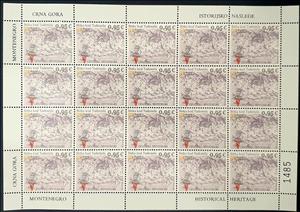Full Pane: Map of the Battle of Tudemila (Montenegro 2012)
Map of the Battle of Tudemila (Montenegro 2012)
12 November (Montenegro ) within release Cultural Heritage (2012) goes into circulation Full Pane Map of the Battle of Tudemila face value 20*0.95 Euro
| Full Pane Map of the Battle of Tudemila in catalogues | |
|---|---|
| Colnect codes: | Col: ME 2012.11.12-4a |
Full Pane is square format.
Footnoted in: MichelAlso in the issue Cultural Heritage (2012):
- Full Pane - Historical Hand Printing Press, Book Page face value 20*0.30;
- Full Pane - Map of the Battle of Tudemila face value 20*0.95;
- Full Pane - Pava and Ahmer face value 20*0.40;
- Full Pane - Piva Monastery face value 20*0.30;
Full Pane Map of the Battle of Tudemila it reflects the thematic directions:
A coat of arms is an heraldic visual design on an escutcheon (i.e. shield), surcoat, or tabard. The coat of arms on an escutcheon forms the central element of the full heraldic achievement which in its whole consists of shield, supporters, crest, and motto. A coat of arms is traditionally unique to an individual person, family (except in the United Kingdom), state, organisation or corporation.
A map is a symbolic depiction emphasizing relationships between elements of some space, such as objects, regions, or themes. Many maps are static, fixed to paper or some other durable medium, while others are dynamic or interactive. Although most commonly used to depict geography, maps may represent any space, real or imagined, without regard to context or scale, such as in brain mapping, DNA mapping, or computer network topology mapping. The space being mapped may be two dimensional, such as the surface of the earth, three dimensional, such as the interior of the earth, or even more abstract spaces of any dimension, such as arise in modeling phenomena having many independent variables. Although the earliest maps known are of the heavens, geographic maps of territory have a very long tradition and exist from ancient times. The word "map" comes from the medieval Latin Mappa mundi, wherein mappa meant napkin or cloth and mundi the world. Thus, "map" became the shortened term referring to a two-dimensional representation of the surface of the world.


